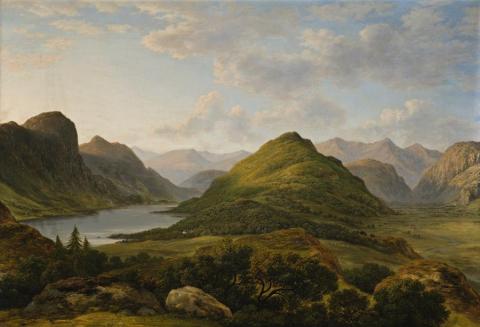LEATHE'S WATER, SKIDDAW AND SADDLEBACK IN DISTANCE, c.1816-17
JOHN GLOVER
oil on canvas
75.0 x 111.0 cm
inscribed on old label verso: Leathe's Water / Skiddaw and Saddleback in distance / J. Glover
Kurt Albrecht Collection, Melbourne, since the 1970s
Thence by descent
Private collection, Melbourne
John Glover couched his paintings in a golden glow reflecting the age of their genesis, a similarly golden time often referred to as the age of enlightenment. A devoted classicist and admirer of the great French master Claude Lorrain, Glover invested all his art with an order and beauty that gives it an ageless serenity. Moreover, his exactness of observation was such that his paintings of Van Diemen's Land of the eighteen-thirties into the forties are among the first to realize the unique peculiarities of its landscape, a kind of untouched paradise of man and nature at one. Glover's fame, however, was not Australian made, for when he came to the Antipodes in 1831 he already had an established reputation, being well known as the 'English Claude'. He dressed his art in the then fashion of the Picturesque with its delight in the magnificence of mountain landscapes touched by the sublime, the orderliness of man made pastoral calm the more pronounced by contrast with the rugged wilds. Leathe's Water, Skiddaw and Saddleback in Distance of about 1816-17 is a classic example. It's very grandeur inspires a similar mood as the eye explores the splendour of the panorama and the civilized touches nestling within.
The English Lakes District has long appealed to the painter and poet. In 1783 Thomas Gainsborough painted there; also J.M.W. Turner and Constable, who toured the district in 1806. Glover's passion resulted in many visits between 1793 and 1824, eventually settling at Blawick Farm on Ullswater near the village of Patterdale.1 Of the peak of Helvellyn, Britain's third highest mountain, William Wordsworth was inspired to write - 'From the watch-towers of Helvellyn: Awed, delighted, and amazed!'2 In Glover's painting the mighty Helvellyn is seen to the east, viewed from the south, Raven Crag rises to the west of Leathe's Water, and mounts Skiddaw and Saddleback are in the further distant east. Amidst such natural splendour, Glover engaged a clarity and high finish to enable the achievements of human endeavour also to be seen, not insignificant within such wonders. A boatman plies still waters, sheep graze on cleared land, and a home finds its place among the woods - believed to be Dalehead Hall, the ancestral home of the Leath family since Elizabethan times of the seventeenth century. Glover envelops all in a mood of calm and classical order, the nobility of man nestled within that of nature in the sparkling light and wondrous beauty of the landscape of Cumbria.
1. When Glover settled in Tasmania, he called his property 'Patterdale' after this village in the Lakes District.
2. On Her First Ascent to Helvellyn
DAVID THOMAS
